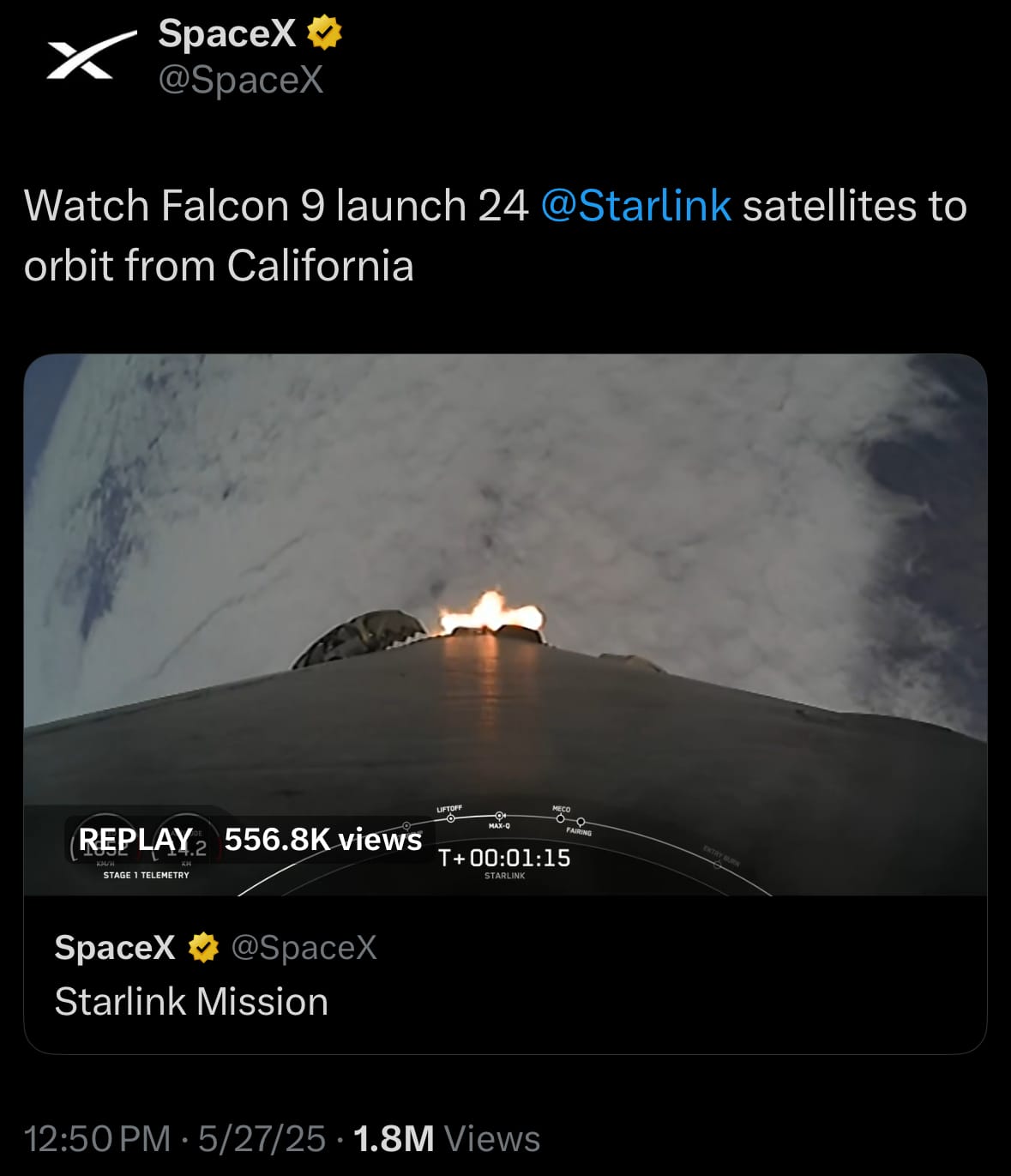Wednesday☕️

Trending:
- Yesterday, May 27, 2025, an explosion occurred at the Shandong Youdao Chemical plant in Gaomi, Shandong province, China, just before noon local time (11:57 a.m., 0357 GMT). The blast killed five people, left six missing, and injured 19 others, while causing widespread damage, including shattered windows in nearby buildings and a large fireball with thick smoke, as seen in footage. The incident triggered a response from over 200 emergency workers, with rescue efforts underway to locate the missing individuals.

- The Shandong Youdao Chemical plant, located in an industrial park in Weifang city, is the world’s largest producer of the pesticide thiamethoxam and also develops technology for pharmaceuticals and fine chemical intermediates. The explosion raised concerns about potential environmental risks due to the chemicals involved, though no immediate reports confirmed contamination. This event highlights the dangers of chemical manufacturing in industrial zones and may lead to investigations into the cause, potentially prompting stricter safety measures in the future.
Economics & Markets:
- Yesterday's U.S. stock market:

- Yesterday’s commodity market:

- Yesterday’s crypto market:

Geopolitics & Military Activity:
- Yesterday, May 27, 2025, a drone strike targeted the Kronstadt facility in Dubna, near Moscow, a site focused on developing unmanned aerial vehicles (UAVs). The attack, which began around 11:41 p.m. EDT, involved at least one drone crashing into the facility, with video footage capturing the moment of impact. Posts on X from local sources reported ongoing attacks on the Kronstadt plant, which produces UAVs like the Orion strike and reconnaissance drone, with geolocation data pinpointing the strike coordinates. Russian authorities claimed to have shot down multiple Ukrainian drones during this wave, though the assault on the facility continued into the early hours of May 28.

- Within the past 24 hours, this strike was part of a broader series of drone incidents across the Moscow region and beyond. Moscow Mayor Sergei Sobyanin reported that at least 10 drones were downed near the capital, with no casualties noted in those specific incidents. Russia’s Defense Ministry stated that 148 Ukrainian drones were intercepted between 10 a.m. on May 25 and 8 a.m. on May 26, indicating a significant escalation in drone activity. Additionally, three of Moscow’s four airports suspended flights on May 27 due to the drone threats, highlighting the scale of the disruptions caused by these attacks in the region.
Environment & Weather:

Space:
- Yesterday, May 27, 2025, SpaceX successfully launched the Starlink Group 17-1 mission from California at 12:57 p.m. EDT, as indicated by launch tracking data. The mission involved a Falcon 9 rocket carrying 24 Starlink V2-mini satellites into low Earth orbit.

- Yesterday, May 27, 2025, SpaceX launched its ninth Starship test flight from Starbase, Texas, at 7:36 p.m. EDT, aiming for a successful orbit and splashdown in the Gulf of Mexico. However, the Starship spacecraft ran into trouble during its coast phase when leaks caused the main fuel tank to lose pressure, making it lose control. This led to an explosion—called a "rapid unscheduled disassembly" by SpaceX—before it could splash down, with the FAA noting the failure.

- The launch began well, with all 33 Raptor engines firing correctly as the Starship separated from its Super Heavy booster during hot-staging, and it kept its heat shield tiles intact, a step up from past tests. The Super Heavy booster, after separating, successfully performed its boostback burn and landed in the Gulf of Mexico as planned, about seven minutes after launch. While the booster’s landing was a success, Starship’s explosion showed SpaceX still has challenges to solve for reliable Starship missions.
Science & Technology:
- Yesterday, May 27, 2025, Anthropic announced that web search functionality is now accessible to all Claude AI users on the free plan. This feature enables Claude to perform web searches and include inline citations in responses, allowing users to check the sources of the information provided. The addition aims to improve the accuracy and transparency of Claude's answers, supporting users who need reliable information for various tasks. This step is part of Anthropic's broader efforts to enhance Claude's capabilities and make them available to a wider audience.

- Also on May 27, 2025, Anthropic introduced a beta version of voice mode for Claude on mobile devices, adding another way for users to interact with the AI. This mode supports hands-free operation, with suggested functions like summarizing calendars or searching documents. For example, Claude can respond to technical questions, such as detailing changes between TypeScript versions 5.4 and 5.5, as demonstrated in a sample interaction. These updates align Anthropic with other AI platforms, such as xAI's Grok and OpenAI’s ChatGPT, which also provides web search and voice mode features, reflecting a trend toward more accessible and multifunctional AI tools.
Statistic:
- Largest public construction companies by market capitalization:
- 🇫🇷 Vinci: $81.52B
- 🇮🇳 Larsen & Toubro: $58.84B
- 🇪🇸 Ferrovial: $37.64B
- 🇺🇸 D. R. Horton: $37.31B
- 🇨🇳 China State Construction Engineering: $32.24B
- 🇺🇸 Lennar: $27.60B
- 🇺🇸 Emcor: $21.28B
- 🇯🇵 Daiwa House: $21.09B
- 🇺🇸 NVR: $21.08B
- 🇺🇸 PulteGroup: $20.15B
- 🇨🇳 China Railway Group: $17.82B
- 🇨🇳 China Communications Construction: $17.20B
- 🇫🇷 Bouygues: $16.77B
- 🇪🇸 Grupo ACS: $16.71B
- 🇯🇵 Sekisui House: $14.82B
- 🇩🇪 Hochtief: $14.42B
- 🇨🇳 China Railway Construction: $13.88B
- 🇫🇷 Eiffage: $13.26B
- 🇯🇵 Kajima: $11.64B
- 🇨🇦 AtkinsRéalis: $11.32B
- 🇯🇵 Obayashi: $10.66B
- 🇺🇸 Toll Brothers: $10.61B
- 🇦🇹 Strabag: $10.38B
- 🇺🇸 Procore: $10.17B
- 🇸🇪 Skanska: $9.96B
History:
- Cranes have been essential to human construction and industry for millennia, evolving from rudimentary tools to advanced machinery. The earliest cranes emerged around the 6th century BC in ancient Greece, starting with simple lever-based devices like the shaduf, used for lifting water or light loads. The Greeks progressed to the trispastos, a three-pulley system, and the Romans later developed the polyspastos, a sophisticated crane powered by human or animal labor, capable of lifting several tons. By the Middle Ages, treadwheel cranes, driven by workers walking inside large wheels, became common in Europe, particularly for building cathedrals and castles. These early cranes utilized pulleys, winches, and counterweights, establishing the foundation for modern lifting technology.
- The Industrial Revolution transformed crane development, with steam-powered cranes introduced in the late 18th century, greatly enhancing lifting capacity and efficiency. By the 19th century, cranes were vital in ports, factories, and railway yards, with designs like the derrick and gantry crane gaining prominence. The 20th century saw further advancements with electric and hydraulic cranes, improving precision and mobility. Tower cranes, critical for modern skyscraper construction, were perfected in the 1940s, while mobile and telescopic cranes increased versatility. Today, cranes incorporate advanced materials, computer controls, and automation, reflecting a legacy of engineering innovation that continues to drive global infrastructure and industry.
Image of the day:

Thanks for reading!
Earth is complicated, we make it simple.
Click image to view the Earth Intelligence System:



Support/Suggestions Email:
earthintelligence@earthintel.news




